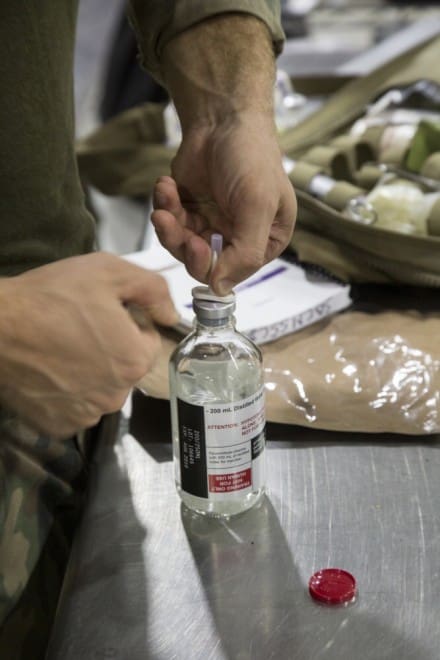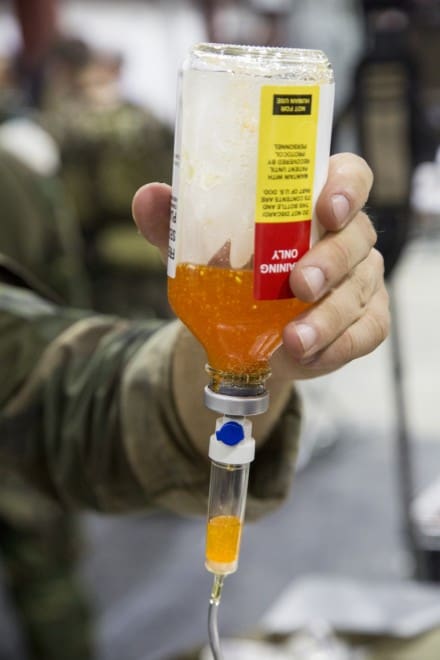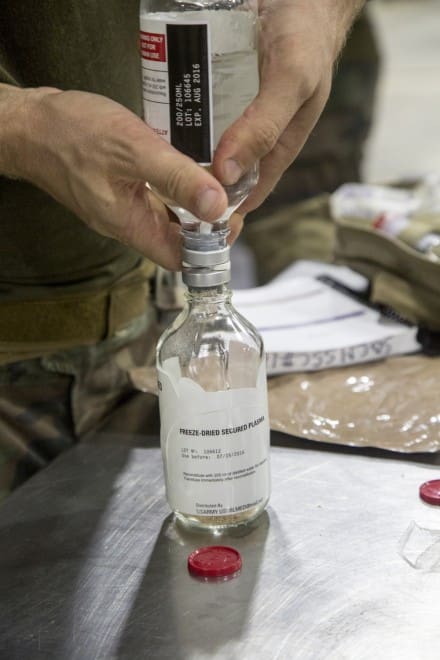The life of a foreign partner nation force member was saved last month through MARSOC’s first operational use of freeze-dried plasma.
The foreign ally sustained life-threatening injuries during an operation in the U.S. Central Command area of operations, requiring battlefield trauma care made possible by MARSOC training and availability of the new product.
According to U.S. Navy Lt. Eric Green, force health protection officer, freeze-dried plasma is providing better medical care on the battlefield. Green is the study coordinator with MARSOC Health Services Support. He explained that freeze-dried plasma is a dehydrated version of plasma that replaces the clotting factors lost in blood. Typically, plasma is frozen and thawed over a period of five days, preventing quick use in a deployed setting.
Another disadvantage of traditional blood products for special operations is the need for additional equipment, such as refrigerators and electricity. This creates a higher target profile for special operations forces (SOF) teams, and presents a logistical challenge for Navy corpsmen. Use of such equipment, as well as timely casualty evacuation options, is not always possible during SOF missions. FDP eliminates the need for this equipment and buys precious time for corpsmen to treat the injured before evacuation.
“I think it reassures Raiders that when they’re in harm’s way, they have a life-saving product in the medical bags of their very capable corpsmen,” said Green.
With the need for freezing and refrigeration eliminated, FDP can sustain a wider range of temperatures and is therefore more stable and reliable than traditional plasma during military operations. The dehydrated state of the plasma allows for a shelf life of two years and is compatible with all blood types. Before MARSOC received approval to begin use of freeze-dried plasma, battlefield treatment options for hemorrhaging – the leading cause of preventable death on the battlefield – were mainly limited to tourniquets and chemical clotting agents.
“It is stable in the field unlike whole blood or if we were to do fresh plasma or frozen plasma, so our guys can carry it with them in their resuscitative packs,” said U.S. Navy Capt. Necia Williams, FDP primary principal investigator and MARSOC force surgeon with MARSOC HSS. “They can quickly reconstitute it, infuse it to somebody and it buys time that is so critical.”
According to U.S. Navy Lt. Aaron Conway, Marine Raider Regiment surgeon with MARSOC HSS, reconstitution happens within six minutes and patients start showing improvement in vital signs minutes later. The precious time bought using FDP allows medical personnel to transfer patients to a hospital where they can receive full medical care. Conway, MARSOCs FDP principal investigator, said during medical care, FDP’s effects can be physically seen most in a patient when surgery and recovery is happening.
Since December 2016, every MARSOC special amphibious reconnaissance corpsman deploys with a supply of freeze-dried plasma and the experience to administer it. By October 2017, every MARSOC unit deployed will be outfitted with FDP.
Once the FDP has returned unused from a deployment it goes into quarantine and gets used during training exercises to prepare Navy corpsmen in its use. Corpsmen go through a rigorous academic and practical training process to prepare them for the field. They get practical experience before deploying and learn how to reconstitute and identify the indications to use FDP.
“We’ve trained with it, we’ve sourced it to our guys, and now we’ve actually got the combat wounded application of the product,” said Conway. “I think it is a tip of the spear life-saving measure.”
This life-saving measure is manufactured by French Centre de Transfusion Sanguine de Armees and used since 1994. They provide the U.S. with FDP while it is pending Food and Drug Administration approval and is under an Investigative New Drug protocol. Currently the use of FDP has been allowed within U.S. Special Operations Command. MARSOC was the second service component within U.S. Special Operations Command to receive approval for use of freeze-dried plasma.
In 2010, U.S. Navy Adm. William H. McRaven, then-SOCOM commander, learned that U.S. allied forces were using FDP successfully in Iraq and Afghanistan. McRaven wanted it made available to U.S. forces, so he pushed his plan and helped expedite the process between the White House and the FDA.
The main roadblock getting FDA approval was the historical spike of Hepatitis B after World War II, causing the stoppage of production and use by U.S. forces, resulting in rigorous testing and changes to the original formula. Plasma donors now undergo more testing for infectious diseases to prevent similar events. Freeze-dried plasma is expected to receive FDA approval by 2020.
Story by Cpl. Bryann Whitley
U.S. Marine Corps Forces, Special Operations Command
U.S. Marine Corps photo by Sgt. Salvador R. Moreno)





JSOM had an article back in 2006/7 IIRC that mentioned the Germans using it, glad to see it’s finally on board.
https://www.google.com/url?sa=t&source=web&rct=j&url=https://www.jsomonline.org/Editorials/2010349Pennardt.pdf&ved=0ahUKEwit0P3p1qDWAhVk4IMKHTy-DGIQFghCMAg&usg=AFQjCNEC0GjJ7UrBL3aESiosGxmUg6EUpA
Link to the article if anyone is interested.
This is probably the coolest thing I’ll read all day.
Yay for technology!
It’s about friggin’ time!
“Hi, we’re from the FDA; and we’re here to help . . . ”
Approval by 2020!?! For something that has been used for almost two decades in other developed nations. What a waste of time and lives.